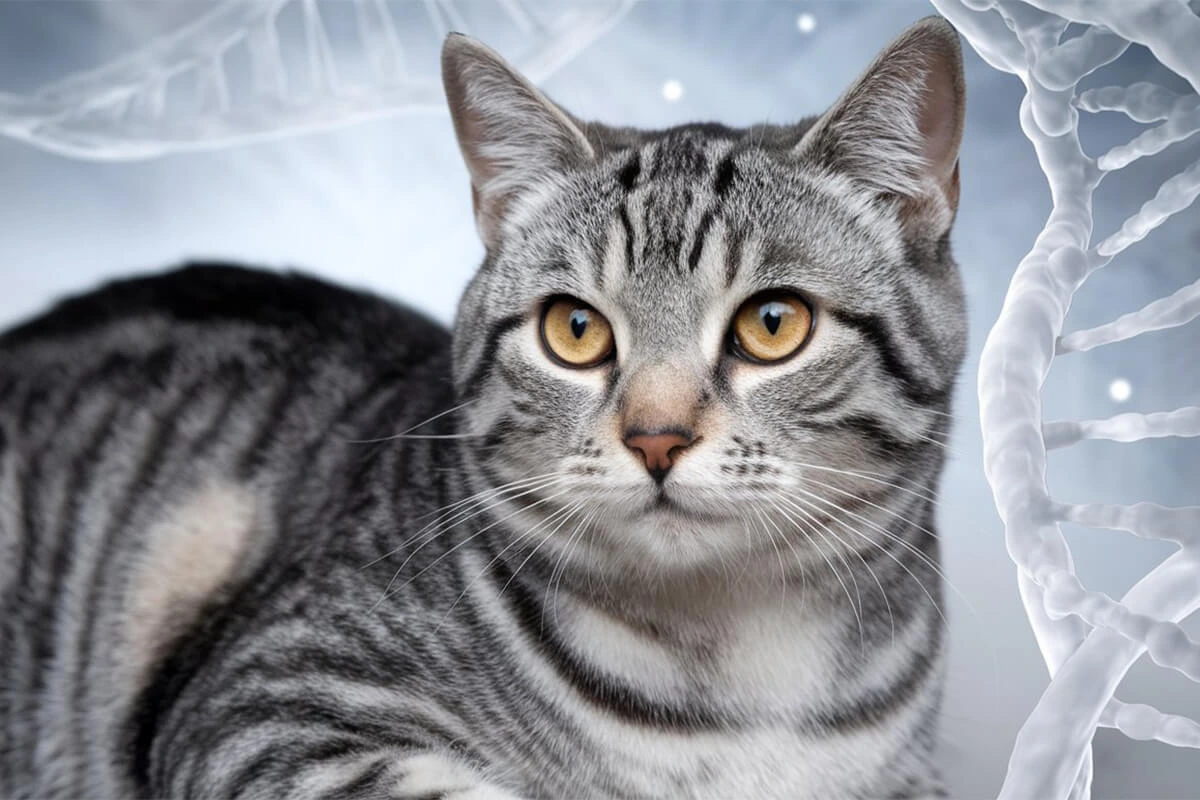A grey cat with stripes is one of the most striking and beloved feline companions. With their beautifully patterned fur, captivating “M” markings on their foreheads, and playful personalities, these cats stand out in any home. Whether they have classic, mackerel, or spotted tabby patterns, their unique appearance and charming traits make them a favorite among cat lovers.
But there’s more to a grey cat with stripes than just its looks. These cats have fascinating histories, unique genetic traits, and distinct personalities that many people don’t realize. Some are known for their affectionate and playful nature, while others carry ancient legends tied to their mysterious markings. In this article, we’ll uncover ten fun and surprising facts about these stunning felines, helping you understand what makes them so special!
The Science Behind The Grey cat with stripes
The Tabby Pattern
A grey cat with stripes owes its beautiful markings to the tabby pattern, one of the most common and recognizable feline coat designs. Despite popular belief, “tabby” doesn’t refer to a specific breed but rather to a distinctive pattern found in many cats. A grey cat with stripes can have different tabby variations, each with its own unique look.
- Mackerel Tabby: This pattern features thin, vertical stripes that run parallel down the cat’s sides, resembling fishbones. It’s the most common tabby type and gives a grey cat with stripes an elegant, tiger-like appearance.
- Classic Tabby: Also called the “blotched tabby,” this pattern forms bold, swirling markings along the body. A grey cat with stripes with this pattern looks almost marbled, with large, dark patches of color.
- Spotted Tabby: Some grey cats with stripes have broken lines that appear as spots rather than full stripes, giving them a wild, exotic look.
- Ticked Tabby: Unlike the others, this pattern doesn’t display clear stripes on the body. Instead, the fur has a salt-and-pepper effect, but faint striping may still appear on the legs, face, and tail.
No matter the variation, every grey cat with stripes carries the signature “M” marking on its forehead—a fascinating feature with many myths and legends surrounding its origin.
Grey cat with stripes Genetics
The striking appearance of a grey cat with stripes comes from a mix of genetic traits that determine coat color and pattern. All tabby cats, including grey ones, inherit their stripes from dominant genes that control how pigment is distributed across their fur.
- The Agouti Gene: This gene decides whether a cat will have a tabby pattern. If a grey cat with stripes carries the dominant agouti gene, its coat will display clear, defined striping.
- Dilution Gene: A grey cat with stripes gets its soft, silver-toned fur from the dilution gene, which lightens black pigmentation into a grey (also called “blue”) shade. This is why grey tabbies are often referred to as “blue tabbies” in certain breeds.
- Color Variations: Some grey cats with stripes may have warmer undertones, giving their fur a slightly silver, bluish, or even brownish tint depending on genetics.
Understanding feline genetics helps explain why no two grey cats with stripes look exactly alike. Even within the same litter, kittens can display different shades and stripe patterns based on how their genetic traits combine.
Grey Tabby Breeds
Many popular cat breeds include the Striped grey cat as a recognized coat variation. These breeds not only showcase stunning tabby markings but also have unique personalities and care needs. Some of the most well-known breeds that can feature a grey tabby pattern include:
- American Shorthair: This breed is famous for its silver tabby variation, with bold, dark stripes on a shimmering grey coat. American Shorthairs are affectionate, intelligent, and great family pets.
- British Shorthair: Known for their plush coats and round faces, British Shorthairs often come in a classic tabby pattern. A grey cat with stripes in this breed has a dignified and calm personality.
- Maine Coon: One of the largest domestic cat breeds, the Maine Coon frequently sports a grey tabby coat. These gentle giants are playful, friendly, and highly social.
- Siberian Cat: This long-haired beauty can have a grey tabby pattern, often with a thick, luxurious coat suited for cold climates. Siberians are affectionate and hypoallergenic, making them a great choice for allergy sufferers.
No matter the breed, a grey cat with stripes always stands out with its elegant appearance and charming personality. Whether short-haired or long-haired, these striped beauties bring joy and companionship to their owners.
Unique Personality Traits of The Grey cat with stripes
Affectionate or Independent?
Striped grey cats can have a wide range of personalities, leading many owners to wonder whether they are cuddly lap cats or independent explorers. The answer varies by individual, but most strike a perfect balance between love and self-sufficiency.
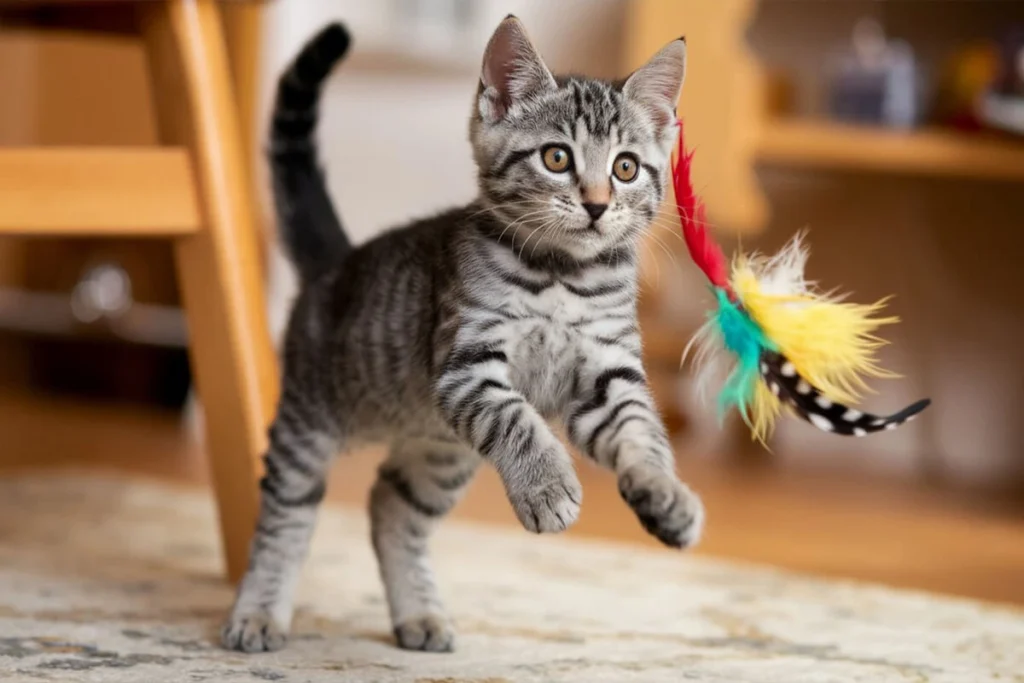
- Loving and Social: Many enjoy curling up with their owners, rubbing against their legs, or snuggling on the couch. Certain breeds, like the American Shorthair and British Shorthair, are particularly affectionate and form strong bonds with their families.
- Independent Thinkers: While they love attention, these cats often have an independent streak. Unlike clingy breeds, they usually entertain themselves and don’t demand constant interaction. They enjoy companionship but also value their alone time.
- Personality Differences by Breed: Some breeds lean toward being affectionate, while others prefer independence. Maine Coons and Siberians are known for their loving nature, while British Shorthairs tend to be more reserved but still enjoy their owners’ company.
These cats typically show affection on their own terms, coming for attention when they want it but also enjoying solo play and exploration. Understanding their balance of love and independence helps build a strong, trusting bond.
Playful and Energetic
Striped grey cats aren’t just beautiful—they’re also full of energy! They love interactive games, have strong hunting instincts, and stay playful well into adulthood.
- Love for Toys and Games: Many enjoy chasing toys, batting at feather wands, and pouncing on moving objects. Toys that mimic prey—like toy mice or laser pointers—bring out their excitement.
- High-Energy Playtime: These cats often have sudden bursts of energy, zooming around the house, climbing furniture, and leaping onto high places. Providing climbing trees, scratching posts, and tunnels keeps them entertained.
- Kitten-Like Behavior into Adulthood: Some retain their playful nature even as they grow older. While some cats become more relaxed with age, many stay active and love interactive games.
Be prepared for spontaneous play sessions, entertaining antics, and a pet that always finds a way to have fun!
Intelligent and Curious
Beyond their playful nature, these cats are also highly intelligent. They have strong problem-solving skills, a natural curiosity, and a keen ability to learn new tricks.
- Quick Learners: Many can pick up on routines, commands, and even tricks like fetching, opening doors, or using puzzle toys with ease.
- Curiosity Leads to Mischief: They love exploring, whether it’s investigating a new box, climbing onto a high shelf, or poking around in bags. Owners often find them squeezing into unexpected spaces!
- Enjoys Puzzle Toys and Challenges: Because of their intelligence, they thrive on mentally stimulating activities. Puzzle feeders, treat-dispensing toys, and interactive challenges help keep them engaged and prevent boredom.
These cats aren’t just pets—they’re clever companions that love to discover the world around them. Keeping their minds active with games and problem-solving activities ensures they stay happy and engaged.
Fun and Surprising Facts About The Grey Cat with stripes
Ancient Origins
A grey cat with stripes isn’t just a modern household pet—its ancestors go back thousands of years. Tabby-patterned cats, including grey tabbies, have a rich history that traces back to wild cats in the Middle East and Africa. Their striped coats evolved as a form of camouflage, helping them blend into their surroundings while hunting.
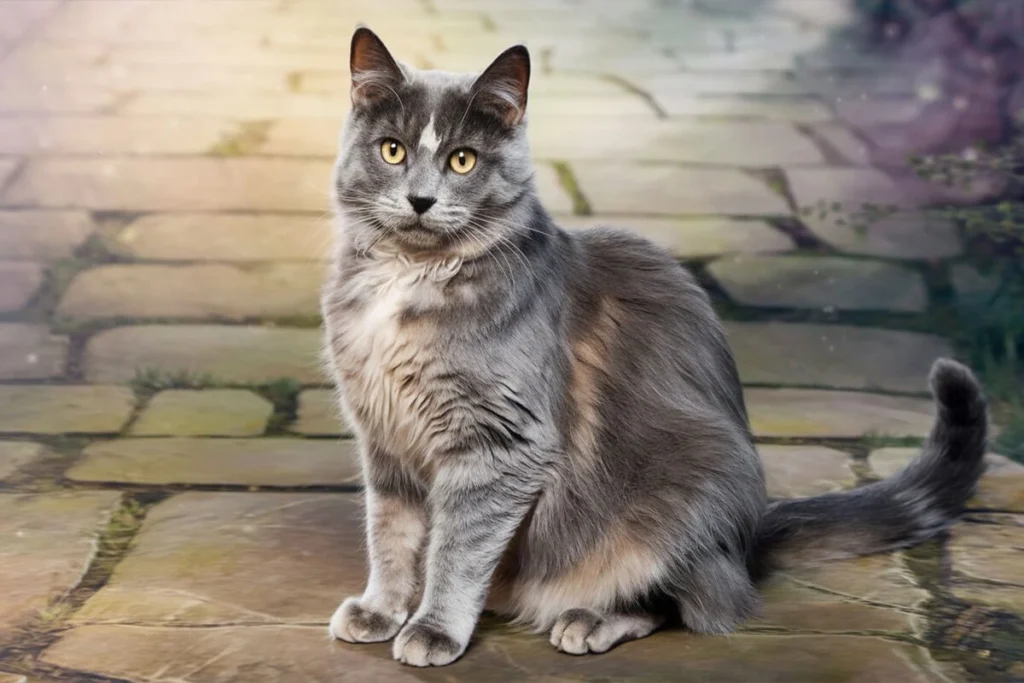
- Wild Cat Ancestry: The ancestors of today’s grey cats with stripes were the African wildcats (Felis lybica), which had similar tabby markings. These wildcats lived in deserts and forests, using their striped coats to stay hidden from predators and prey.
- Domestication and Travel: As humans began domesticating cats around 9,000 years ago, these striped felines started living alongside people. Merchants and sailors brought them on ships to control rodent populations, helping spread tabby cats across the world.
- Tabbies in Ancient Civilizations: Artifacts from Ancient Egypt, Rome, and even medieval Europe depict cats with stripes, showing that the grey cat with stripes has been a part of human history for centuries. Egyptian art often featured striped cats, and some historians believe they were even worshiped for their hunting skills and mysterious beauty.
The long history of the grey cat with stripes proves that these felines have been valued and admired for thousands of years. Today, their ancient lineage lives on in their distinctive coats and unique personalities.
The “M” Marking Mystery
One of the most fascinating features of a grey cat with stripes is the bold “M” marking on its forehead. Every tabby cat, including grey tabbies, has this distinct symbol, and it has inspired many myths and legends over time.
- The Egyptian Legend: Ancient Egyptians believed that tabby cats were sacred animals. One story claims that the goddess Bastet, the protector of cats, placed the “M” on tabby foreheads as a mark of honor.
- The Christian Folklore: Another legend tells of a tabby cat that comforted baby Jesus in the manger. According to the story, the Virgin Mary stroked the cat’s head, leaving behind the “M” as a sign of her blessing.
- The Islamic Tale: In Islamic tradition, the Prophet Muhammad had a beloved cat named Muezza. One story says that Muhammad gently touched the cat’s forehead, giving tabbies their distinctive marking as a symbol of protection.
- Scientific Explanation: While the legends are fascinating, science offers a simpler explanation. The “M” marking is a natural genetic trait that comes with the tabby pattern. The way pigment forms in a grey cat with stripes naturally creates this forehead marking, making it a signature trait of all tabby cats.
Whether you believe in the myths or the science, the “M” on a grey cat with stripes is one of its most recognizable and cherished features!
Their Coat Changes Over Time
A grey cat with stripes may not always look the same throughout its life. Many tabby cats experience coat changes as they grow, with subtle shifts in color, contrast, and pattern.
- Kittens vs. Adults: A grey tabby kitten might have faint or blurred stripes when it’s young. As it matures, the markings often become more pronounced, with stronger contrast between the dark and light areas.
- Seasonal Coat Changes: Some grey cats with stripes may appear darker or lighter depending on the season. This happens because of natural shedding and new fur growth, which can slightly alter the color intensity.
- Aging and Fur Lightening: As a grey cat with stripes gets older, its coat may fade or develop a silvery tone. Some senior cats even get white hairs around their muzzle and paws, similar to how humans get gray hair with age.
- Influence of Diet and Health: A cat’s nutrition and overall health can also affect coat color. A well-balanced diet with essential nutrients helps maintain the richness and shine of a grey cat with stripes. If a cat’s fur starts to look dull or patchy, it may be a sign of dietary or health issues.
Watching how a grey cat with stripes changes over time adds to the joy of owning one. No matter how their coat shifts, their beauty remains undeniable!
Best Care Tips for Grey Striped Cats
Grooming Needs
A grey cat with stripes may not require as much grooming as long-haired breeds, but regular care keeps its coat looking sleek and healthy. The tabby pattern stands out best when the fur is clean, smooth, and well-maintained. Grooming also helps reduce shedding and prevents hairballs, making it essential for both the cat’s health and your home’s cleanliness.
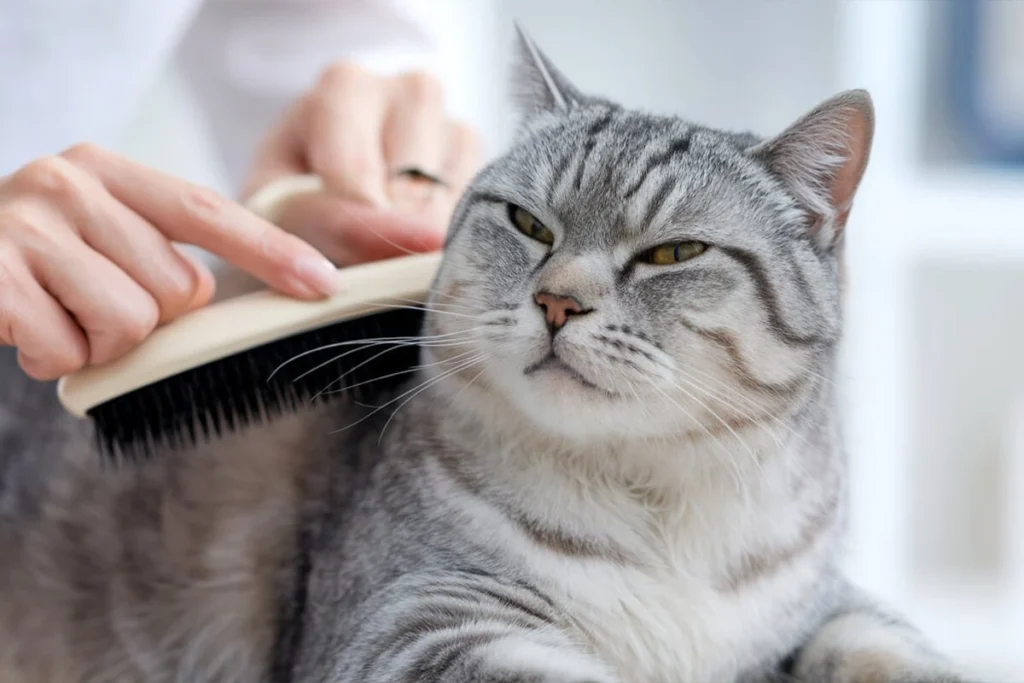
- Brushing Routine: Even though most grey cats with stripes have short to medium fur, brushing them at least twice a week removes loose hair and distributes natural oils that keep their coat soft and shiny. If the cat has a longer coat, like a Maine Coon or Siberian, brushing should be done daily to prevent tangles and matting.
- Bathing (When Necessary): Most grey cats with stripes keep themselves clean, but occasional baths can help if their fur becomes greasy or dirty. Using a mild, cat-safe shampoo ensures their coat stays fresh without irritating their skin.
- Shedding Control: While tabbies aren’t the heaviest shedders, they still leave behind some fur, especially during seasonal coat changes. Regular brushing and a healthy diet help manage shedding and keep loose hairs off your furniture.
- Nail and Ear Care: Grooming isn’t just about fur. Keeping their nails trimmed prevents scratching issues, and checking their ears weekly helps catch any dirt or infections before they become a problem.
By sticking to a simple grooming routine, a grey cat with stripes will always look its best and feel comfortable in its well-maintained coat.
Nutrition for a Healthy Coat
A grey cat with stripes needs a nutritious diet to maintain a soft, shiny coat and overall good health. What a cat eats directly affects the condition of its fur, making high-quality food essential for keeping its striped coat vibrant and healthy.
- Protein for Strength: Cats are obligate carnivores, meaning their bodies thrive on animal-based proteins. Feeding a grey cat with stripes a diet rich in high-quality protein (such as chicken, turkey, or fish) helps keep its fur strong and reduces excessive shedding.
- Essential Fatty Acids: Omega-3 and Omega-6 fatty acids, found in fish oil and high-quality cat food, improve coat texture, reduce dryness, and add shine to a grey cat with stripes. Some owners supplement with fish oil or flaxseed oil for extra benefits.
- Hydration for Skin Health: Proper hydration plays a big role in coat quality. A grey cat with stripes should always have access to fresh water, and wet food can help increase moisture intake. Not drinking enough water can cause your skin to become dry and flaky, and your hair or fur to look dull.
- Vitamins and Minerals: Vitamins A, E, and B-complex support healthy skin and fur. Foods with antioxidants also help prevent inflammation and keep a grey cat with stripes looking vibrant and well-groomed.
A balanced diet keeps a grey cat with stripes not only looking great but also feeling energetic and healthy from the inside out!
Interactive Playtime with Grey cat with stripes
It isn’t just about looks—it’s also a playful and intelligent companion that needs regular mental and physical stimulation. Engaging in interactive play helps satisfy a cat’s natural hunting instincts while keeping it active and happy.
- Chasing and Pouncing Games: Toys that mimic prey, like feather wands or moving mice, excite a grey cat with stripes by triggering its natural stalking and chasing instincts. These games provide both exercise and entertainment.
- Puzzle Toys and Treat Dispensers: Because tabby cats are intelligent, they love challenges. Puzzle feeders or treat-dispensing toys keep a grey cat with stripes mentally stimulated while rewarding problem-solving skills.
- Climbing and Scratching Fun: Many grey cats with stripes enjoy climbing and exploring their surroundings. Cat trees, shelves, and scratching posts satisfy their urge to climb and scratch while protecting furniture from damage.
- Playtime with Owners: A grey cat with stripes often bonds deeply with its owner during play. Engaging in regular interactive play strengthens the relationship and prevents boredom-related behavior issues.
By incorporating daily play sessions, a grey cat with stripes stays physically fit, mentally sharp, and emotionally content—leading to a happier, more well-rounded feline companion.
Are Grey Striped Cats the Right Pet for You?
Family-Friendly or Solo Companion?
A grey cat with stripes can thrive in different types of households, whether it’s a lively family environment or a quiet home with a single owner. Their adaptable nature makes them a great choice for many pet lovers, but their personality and energy levels play a big role in determining the best fit.
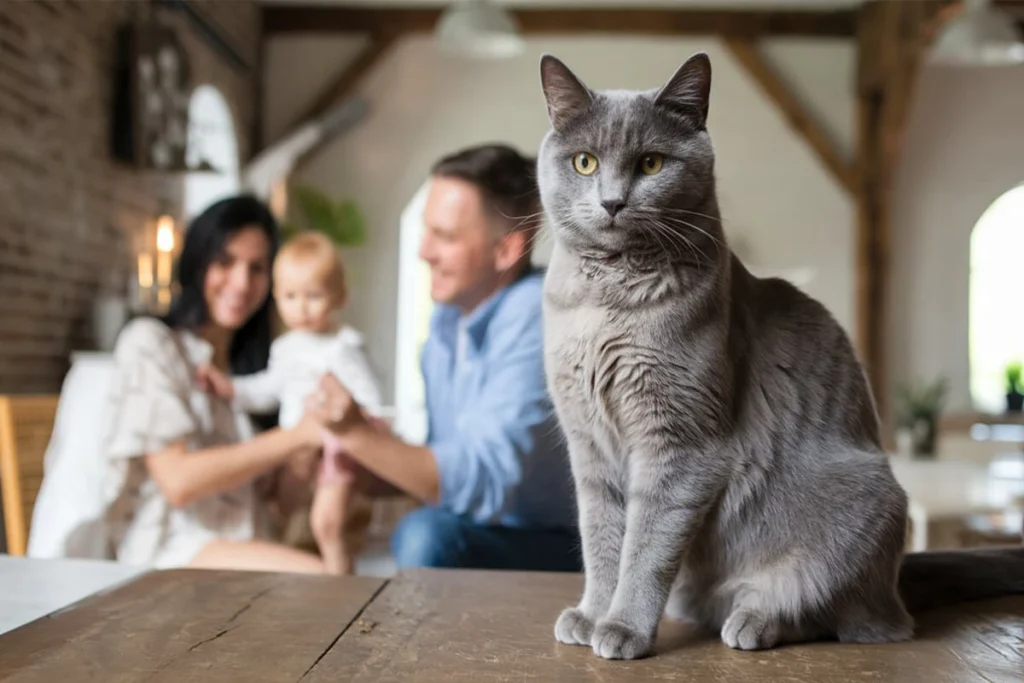
- Great for Families: Many grey cats with stripes are affectionate, playful, and patient, making them wonderful pets for families with children. Breeds like the American Shorthair and Maine Coon are known for their gentle and friendly temperaments. They enjoy interactive play, tolerate being handled, and often seek out companionship.
- Perfect for Solo Owners: A grey cat with stripes can also be a great match for single owners, especially those looking for an independent yet loving companion. Some tabby cats enjoy alone time and entertain themselves well, making them a low-maintenance pet for busy individuals.
- Compatibility with Other Pets: Many grey tabby cats get along with other pets, especially if they are introduced properly. They can coexist with other cats and even dogs, as long as they have a safe space to retreat when needed.
Whether in a bustling household or a quiet apartment, a grey cat with stripes can adapt well, as long as it gets enough attention, stimulation, and care.
Adopting vs. Buying
If you’re considering bringing this cat into your home, you have two main options: adopting from a shelter or buying from a breeder. Each choice has its benefits, and the right decision depends on your preferences and circumstances.
- Adopting a Grey Tabby: Animal shelters and rescue groups often have grey cats with stripes looking for loving homes. Adoption is a great option because it gives a cat in need a second chance while also being more affordable than buying from a breeder. Many shelter cats are already vaccinated and spayed/neutered, reducing initial veterinary costs.
- Buying from a Breeder: If you’re looking for a specific breed, such as a British Shorthair or Maine Coon with a grey tabby coat, purchasing from a responsible breeder might be the best option. A reputable breeder ensures the cat’s lineage is healthy and well-cared for, but this route is often more expensive.
- Things to Consider: Whether adopting or buying, it’s essential to research and choose a source that prioritizes the cat’s well-being. Responsible breeders should provide health records and allow you to meet the kittens in a clean, ethical environment. If adopting, visiting shelters and interacting with available cats can help you find the perfect match.
No matter how you find your grey cat with stripes, the most important thing is providing a loving, safe home where it can thrive.
Lifespan and Long-Term Commitment for Grey cat with stripes
Owning one is a long-term responsibility, as these beautiful felines can live for many years when properly cared for. Understanding their lifespan and needs helps ensure they remain happy and healthy throughout their lives.
- Average Lifespan: A healthy grey cat with stripes typically lives between 12 to 18 years, with some even reaching their early 20s. Indoor cats tend to live longer than outdoor cats because they are protected from accidents, predators, and diseases.
- Commitment to Care: Adopting a grey cat with stripes means committing to years of proper care, including regular vet checkups, high-quality nutrition, grooming, and companionship. Their needs change over time, from playful kittenhood to relaxed senior years.
- Senior Cat Considerations: As a grey tabby cat ages, it may require adjustments in its diet, exercise routine, and medical care. Senior cats may develop arthritis, dental issues, or other health concerns that require extra attention.
Bringing a grey cat with stripes into your home is a long-term commitment, but the love, companionship, and joy they provide make every moment worth it. With proper care, these beautiful felines can remain loyal, loving companions for many years.
Conclusion
Striped grey cats are more than just beautiful pets—they have fascinating histories, unique genetics, and engaging personalities that make them exceptional companions. Whether playful and energetic or calm and independent, they bring joy and warmth to any home.
From their ancient lineage to the mysterious “M” marking on their foreheads, these felines have captured human admiration for centuries. Their coats may change subtly over time, but their charm remains constant. They fit well into various lifestyles, thriving in both active families and quiet households.
Caring for one involves regular grooming, a nutritious diet, and plenty of mental and physical stimulation. With proper care, they can live long, healthy lives, offering companionship and entertainment along the way. Whether adopting from a shelter or selecting a specific breed from a breeder, bringing one into your home is a meaningful and long-term commitment.
If you’re thinking about welcoming a tabby into your life, be prepared for a loyal and loving pet that will keep you entertained and comforted for years to come. Their intelligence, curiosity, and affectionate nature make them truly special members of any family.
Read More About Grey Cats and their Personalities.
Discover the Light Grey Cat Breed! one of the best Grey Cats you can Adopt.
Discover More About Cat Breeds Here!
Find The Best stuff for your Cat on Pet MD Official
